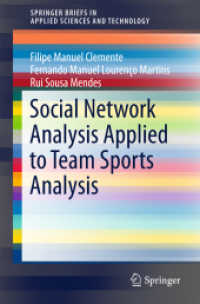Full Description
Many books have been written on the topic of second language assessment, but few are easily accessible for both students and practicing language teachers. This textbook provides an up-to-date and engaging introduction to this topic, using anecdotal and real-world examples to illustrate key concepts and principles. It seamlessly connects qualitative and quantitative approaches and the use of technologies, including generative AI, to language assessment development and analysis for students with little background in these areas. Hands-on activities, exercises, and discussion questions provide opportunities for application and reflection, and the inclusion of additional resources and detailed appendices cements understanding. Ancillary resources are available including datasets and videos for students, PowerPoint teaching slides and a teacher's guide for instructors. Packed with pedagogy, this is an invaluable resource for both first and second language speakers of English, students on applied linguistics or teacher education courses, and practicing teachers of any language.
Contents
Preface; Part I. Engaging with Language Assessments: 1. Language assessments and tests: what do we need to know, and why should we care?; 2. Making sense of the many approaches to language assessment; Part II. Gaining Knowledge of Language Assessment Principles: 3. Context, purpose, and impact: the situation matters; 4. What and who are we measuring? Validity and alignment; 5. Language assessment consistency: uniformity and reliability; Part III. Right or Wrong: 6. Assessing comprehension and knowledge with dichotomously scored item types; 7. Analyzing dichotomously scored items for selecting the most proficient test takers; 8. Judging the effectiveness of items scored as right or wrong; 9. Identifying the masters: evaluating criterion-referenced assessments; Part IV. Judging Test Taker Performances: 10. Being creative: types and delivery of performance assessments; 11. Scoring performance assessments: rating, rating scales, and raters; 12. Judging the effectiveness of performance assessments: validity, reliability, and dependability; Part V. Reflecting and Self Assessment: 13. Evaluating our language assessment literacy; Glossary; References; Index








